 |
Bhutan's
Festivals Tshechu |
|
 |
Bhutan's
Festivals Tshechu |
|
|
 |
|
Glimpses
of Paro Tshechu
|

|
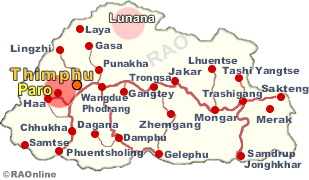 |
|
As
eighty-year old Gyem walks into the courtyard of the dzong, supported by
a walking stick and her grand daughter, a middle-aged woman offers a place
next to her.
Mumbling
a soft 'kadrin che' her attention shifts to the mask dance being performed.
"I have never missed Paro tshechu ever since I was a little girl," she
said.
|
|
Gyem
from Tashidingkha in Paro said she has attended the tshechu countless times.
"When I was a child I came to the tshechu with my parents. Today I have
come with my daughter and my granddaughter," she said.
| Aum
Gyem |
 |
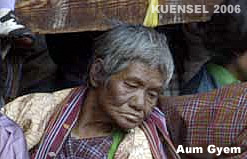 |
| Gyem
has never attended any other tshechu than the Paro tshechu.
When
it is time for the tshechu, Gyem leaves all work. "I woke up early, prepared
lunch and walked to the dzong," she said. She told that over the years
many new features had been introduced in the tshechu, which included boe
chham and zhey. "Today, they even have hundreds of stalls outside,"
she said. As an atsara passes a comment to a girl in the crowd, Gyem bursts
out laughing. "I pray to witness the tshechu for more years to come," she
said, still laughing. |
|
| Bangchungs
out |
 |
|
Paro
Tshechu
It
is lunchtime. Driver Tenzin and his family who are attending the tshechu
take out their midday meal from brand new china made containers. The traditional bangchung
(bamboo container) is not seen.
The
bangchung that used to be commonplace not long ago to carry pack lunch
has now been replaced by hot cases, plastic tiffins and other imported
containers. |
|
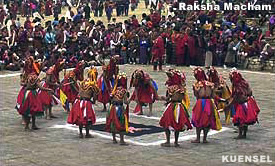 |
|
Paro
Tshechu
"Bangchungs were hardly used these days," said Angay Om, 77. "Before it was a necessity
and for tshechu we selected the best bangchungs," she said, adding that
the curry was wrapped in a plastic and was put inside the bangchung. "It
tasted wonderful."
Chuki from a nearby handicraft stall said that Bhutanese rarely bought bangchungs.
The tourists mostly bought it, as a 'decoration item'. |
|
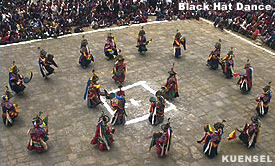 |
| Atsaras |
 |
|
Paro
Tshechu
Picking
up a lunch box from the crowd, the atsaras open it and declares that the
harvest this year will be 'good'.
"That's
if the food inside the box is up to the brim," said one of the three
atsaras after performing zachum/soekha on the first day of the
tshechu.
Besides
entertaining and having role and significance of their own, atsaras of
the Paro tshechu have an additional role to play, according to the atsara
gom (head) Kinley. |
|
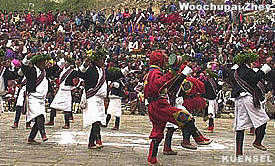 |
| Pesar
for children |
 |
|
Paro
Tshechu
A
group of children enter the Paro Rinpung Dzong, giggling and pulling at
each other.
Most
of the children, especially girls, were wearing the hand woven pesar(new design) kiras.
"I
am wearing the pesar kira for the first time," said Dema, a Class VI student.
"I used to wear the machine made kira or the plain mathra for the tshechu."
The pesar
kira appears to be the most popular wear among children under 16 years
at the Paro tshechu.
Sedey,
also a Class VI student, said her mother wove her a pesar kira especially
for the Tshechu. |
|
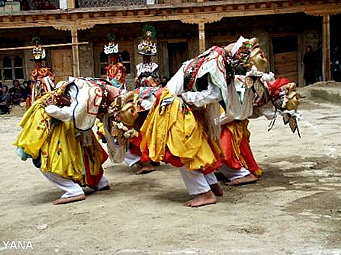 |
|
Paro
Dzong
On
the fourth day, two of the atsaras appear as 'boe', the laymen,
wearing gho. "They represent the two important saints, and signifies
that the saints visit the tshechu on that day and only those who are pious
will recognise them," said Kinley.
Women
who have problems conceiving should approach atsaras few days before the
tshechu and offer a bowl of rice and an egg along with nyendar (monetary
offering) , according to Kinley.
"After
the tshechu, if the egg which is kept in the Ney khang has a mark
or a colour on it, it symbolise the live and death of that child," he said.
On
the last day, the atsaras also
appear as women, played around with men and acted like they have given
birth to bring merit to infertile women. "The child believed to be born
with the blessings of an atsara is usually named Goem, meaning
guest," said Kinley. |
|
 |
Among
the adults few wore the pesar kira. Kira without designs, mostly mathra
and pangtse, was their choice of wear.
"Plain
kiras worn with matching wonju and tego look much better than
the colourful ones," said Tshering Dema, a housewife. Another said that
it was not the design but the neatness and comfort that mattered.
"Pesar
is considered special and usually worn on the last day of the tshechu,"
said a 56-year-old woman from Punakha. "More people attend the tshechu
on the last day," she said.
Among
the men, the bura lungsem and aikapur weave were the popular wear.
 |
| Contributed
by Kesang Dema, KUENSEL, Bhutan's National Newspaper 2006 |
| Information on Bhutan |
 |
 |
|
Paro
dzong |
|










